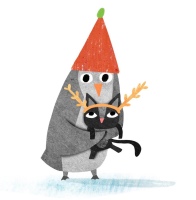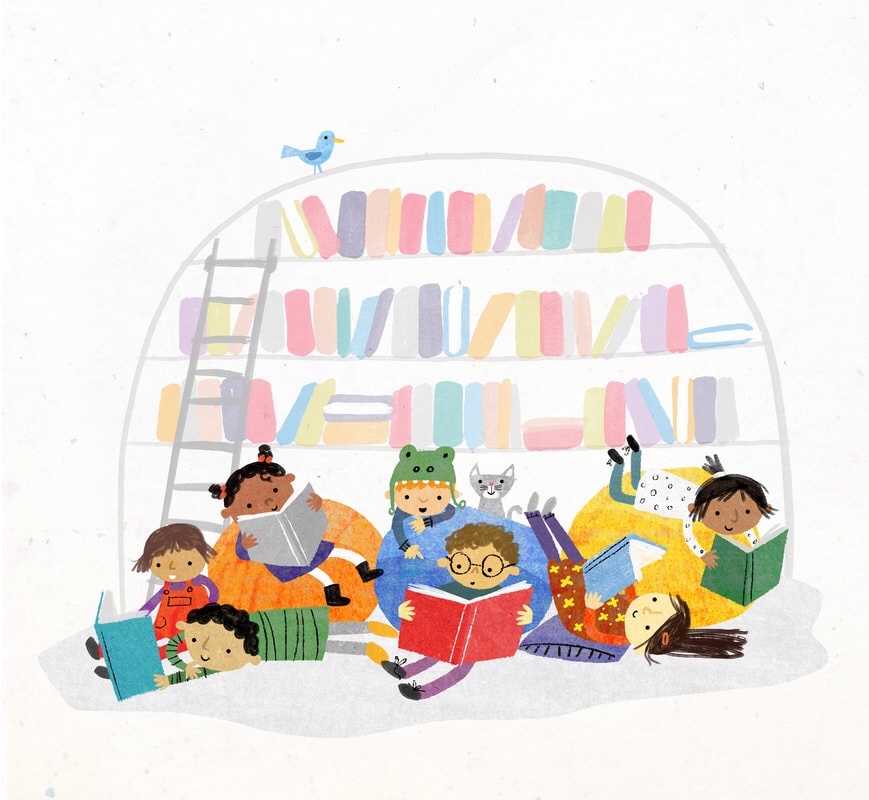Maddie is an author-illustrator from New England and living outside of Boston. She has illustrated many different picture books including her own books, Once Upon a Zzzz, Animobiles: Animals on the Mooove
, and “Wakey Birds (2019).” You can read more about Once Upon a Zzzz
in my post on Creative Writing! Her time studying Animation at Massachusetts College of Art and Design set motion to her journey as a character and story teller in children’s literature. She loves using humor in her art or writing because she’s always believed that silliness is very important! Her work is made from handmade texture that has been scanned and digitally pieced together. (extracted and adapted from Bright Agency profile)
You can connect with Maddie on her website or Twitter.
Thank you, Maddie, for joining me! You’ve worked as an art teacher for students of all ages, but you’ve mentioned especially enjoying teaching elementary school art. What was it about this job that you enjoyed? Do you have any pointers for parents looking to teach art at home?

 Being an elementary art teacher was like being Mary Poppins with a closet full of art supplies. It was such a fun job. I loved seeing how adventurous students were when they worked on projects. As we get older, we are so quick to judge everything we do but children just dive headfirst into making things. Of course, there are students (I was one of them) that hesitate or get easily frustrated in the process. I miss being a source of encouragement the most. I miss sharing those rewarding moments of student success. That end result of seeing all different versions of an assignment together on a wall would bring rainbows and butterflies of joy to my heart. I miss all of that.
Being an elementary art teacher was like being Mary Poppins with a closet full of art supplies. It was such a fun job. I loved seeing how adventurous students were when they worked on projects. As we get older, we are so quick to judge everything we do but children just dive headfirst into making things. Of course, there are students (I was one of them) that hesitate or get easily frustrated in the process. I miss being a source of encouragement the most. I miss sharing those rewarding moments of student success. That end result of seeing all different versions of an assignment together on a wall would bring rainbows and butterflies of joy to my heart. I miss all of that.
I would say if parents are looking to teach art at home, make the fundamentals of art FUN. Every child learns/creates differently so you can be as creative as you want when planning lessons around line, texture, shape, color, form, etc. Whatever works for you and your child.
On your website you mention being a practitioner of yoga and using it to moderate your level of attachment to your work. Yoga is where I learned the phrase, “let go of that which does not serve you,” and I assume you’re talking about the same kind of thing. How has this philosophy helped your process of creating picture books?
One of my yoga teachers says that too! For me, yoga is my art, my art is my yoga. My mindset for both are the same.
In yoga, you learn to let go. Yes, you are stretching and breathing but all of that is to release whatever you are holding on to that is filling your mind with unnecessary clutter. I won’t go too spiritual here but practicing yoga’s philosophy about non-attachment allows me to make art and books without obsessing over the outcome, good or bad (likes, reviews, winning awards, being on some kind of special list). Of course, I want people to like the books I make but I can only do my best. Once a book is complete, it’s complete. I can read it, share it, shout in the middle of a bookstore for everyone to buy it but that won’t change what’s on the pages (that would also be extremely terrifying). If I attached to everything I made I would never make anything else. My work is not my baby. It’s just my work.
Make something, share it, let it go. Rinse and repeat.

As a person who is usually reading 3-5 different books at any given time, I love that you like to write a couple stories at the same time. I often have a variety of books (currently physics, fiction, historical fiction, meditation) and switch around based on my mood and level of mental energy. Do find your stories differing in a similar fashion? What do you find are the benefits of working on more than one storyline at a time? Do they ever intersect?
It’s totally similar! I have a lot of ideas for stories and it can be very overwhelming when all of these imaginary characters beg to be in a book. I know a lot of authors and creators feel the same way. What usually happens is an idea strikes and instead of planning everything out and getting caught up in structure, I force myself to just start writing. If I take too much time thinking everything through nothing will get done. When I hit a wall I’ll start typing another story or open up a WIP. Nothing has intersected yet but if I leave these half-written stories in one folder long enough I’m sure something magical will happen.
You describe your method as a “digital cut and paste,” using different scans of colors and textures. How did you come to use this method? You’ve talked about your style changing with each story to match the characters depicted. How does your method allow your artistic voice adapt to the different characters?
It started while I was a teacher. After school and on the weekends I liked to make my own child-themed art for fun with watercolors and pen. There came a certain point when I felt  bored and frustrated with my way of creating and that’s when I turned to my bookshelf for inspiration. It was Lauren Child’s work that made me want to try patterns and textures. I started scanning fabric then moved to collage paper. Now I make my own textures from crayon, pencil and different paint. I tend to tailor my style depending on the book. For board books, it’s very shape-based with bold colors. For picture books I try to be looser with my cutting and pasting. I know a day will come when I will get bored again but for now this works for me.
bored and frustrated with my way of creating and that’s when I turned to my bookshelf for inspiration. It was Lauren Child’s work that made me want to try patterns and textures. I started scanning fabric then moved to collage paper. Now I make my own textures from crayon, pencil and different paint. I tend to tailor my style depending on the book. For board books, it’s very shape-based with bold colors. For picture books I try to be looser with my cutting and pasting. I know a day will come when I will get bored again but for now this works for me.
Even though your style changes with your characters, it always retains a quality of whimsical fun—I’d say it seems central to your artistic voice. Does this love of whimsy stem from any particular influence or experience?
I am literally just a child in an adult’s body. I’m glad it carries over into my art!
You’ve spoken about aspiring artists needing to keep creating “no matter how much rejection comes your way” and to develop their unique voice. How long did it take you to find your artistic voice? What was your journey into creating published picture books like?
An artistic voice or creative style is kind of like a clothing style. There are things you like to  wear at a certain time and then years go by and you don’t like to wear those kinds of clothes anymore or they just don’t fit. You grow, you change, and your style and voice grows with you. My voice is just a reflection of me Right Now. It’s my personality and sense of humor, my wacky thoughts in my brain. In three years it will shift and change and that is one of the best things about being an artist.
wear at a certain time and then years go by and you don’t like to wear those kinds of clothes anymore or they just don’t fit. You grow, you change, and your style and voice grows with you. My voice is just a reflection of me Right Now. It’s my personality and sense of humor, my wacky thoughts in my brain. In three years it will shift and change and that is one of the best things about being an artist.
 My journey into picture books happened strangely fast. I had been experimenting in my new Lauren Child-way of working and made a portfolio of just-for-fun work while I was teaching. One summer my husband asked me when I would try illustrating full-time, that thing I always wanted to do. The best answer I had was, “um…now?”
My journey into picture books happened strangely fast. I had been experimenting in my new Lauren Child-way of working and made a portfolio of just-for-fun work while I was teaching. One summer my husband asked me when I would try illustrating full-time, that thing I always wanted to do. The best answer I had was, “um…now?”
I didn’t go back to teach the following year and instead flung my portfolio of work into the world to try and get an agent. The Bright Agency scooped me up and I have been working like a mad woman ever since.
Is there anything else you’d like to share?
Just a big THANK YOU to friends who take time to say nice things to me and support my work on social media. I really appreciate it. If I could knock on your door and give you all a hug I would but it might seem creepy. Anyway, thanks.







What wonderful artwork and interesting journey. Thank you for the great post.
LikeLiked by 1 person
So glad you enjoyed it?
LikeLiked by 1 person
Wrong punctuation! I really am glad you enjoyed it 😳☺️
LikeLiked by 1 person
Great questions and interesting answers!
LikeLiked by 1 person
Thanks! Glad you enjoyed it 😄
LikeLiked by 2 people
🙂
LikeLiked by 1 person
Reblogged this on Chrikaru Reads and commented:
I love getting an insight into the creative process of illustrating, especially from a fellow teacher!
LikeLiked by 1 person
Nice post, Enjoyed.
LikeLiked by 1 person
So pleased to hear that ☺️
LikeLike
Big fan! Love the glimpses that Maddie posts on Twitter. Hope she will join Instagram one day! And I am doing my best to get to one of her Boston area appearances for Zzz or ANIMOBILES this spring. Yay!
LikeLiked by 1 person
It would be wonderful to see more of her work on Instagram!
LikeLiked by 1 person
[…] ages 5-8), The Amazing Life Cycle of Butterflies (Look and Wonder) by Kay Barnham, illustrated by Maddie Frost (Barron’s Educational Series, ages 8-12), and Being a Bee by Jinny Johnson, illustrated by […]
LikeLiked by 1 person
[…] Amazing Life Cycle of Butterflies by Kay Barnham, illustrated by Maddie Frost (Barron’s Educational Series, ages 8-12) guides readers through each stage of a […]
LikeLike